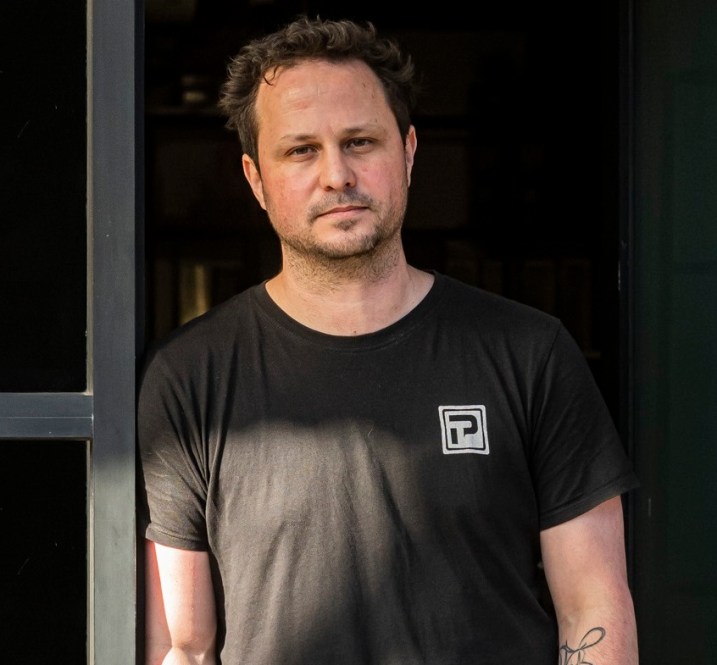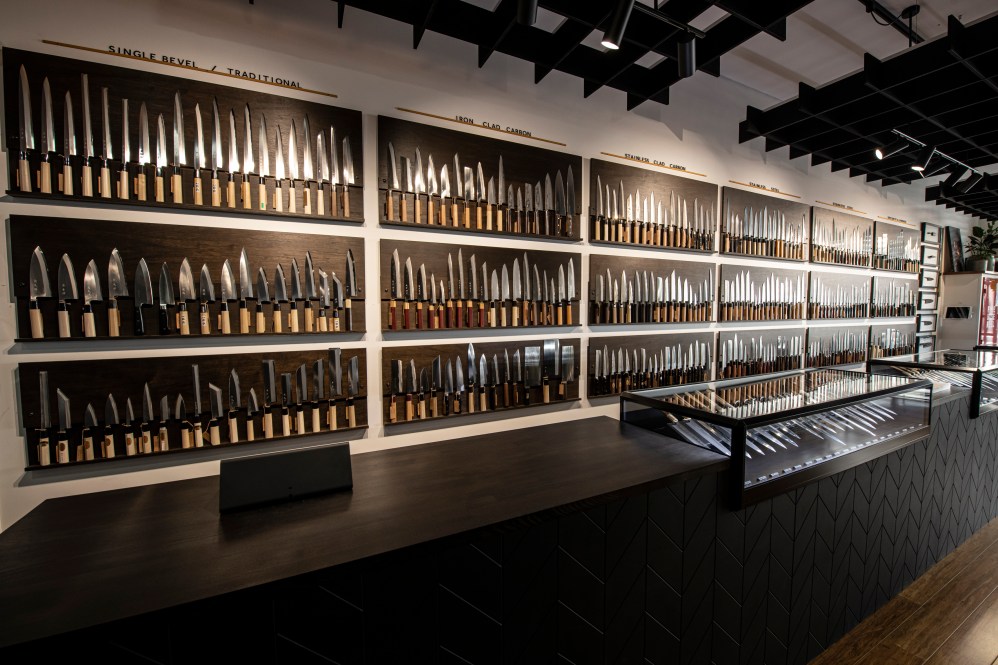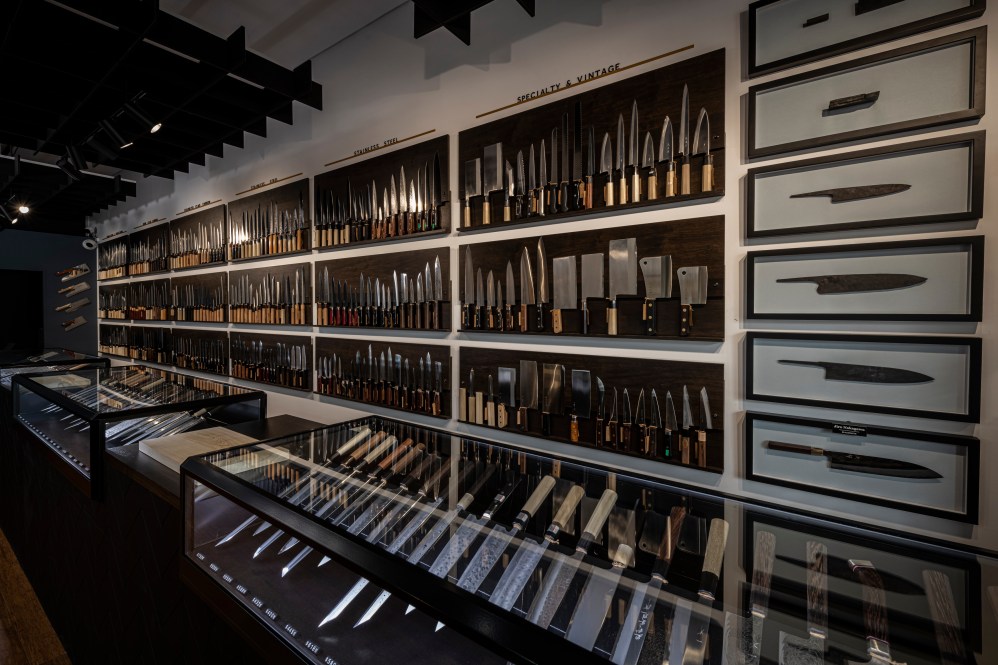Japanese knives are made by experienced hands; ones that have often spent decades honing a specialised craft that combines tradition with performance. The knives are forged from Japanese steels, which range from 58 to 68 on the Rockwell scale, making them considerably tougher than any counterparts.
Skill, knowledge and superior materials are just three of the X factors that have contributed to the iron-clad reputation of Japanese knives, which are in near-constant demand from chefs.
Hospitality speaks to ProTooling’s Paul Tayar and Knives and Stones’ James Zhang — two of the main importers of Japanese knives — about building out a kit, the art of sharpening and why small acts go a long way to ensuring the longevity of your knife.
Paul Tayar and James Zhang didn’t start out in the knife business, but both saw an untapped opportunity after they couldn’t find what they were looking for. Tayar was surrounded by food and cooking growing up with woodworking in the background, while Zhang was an engineer and a fishing enthusiast. “I was collecting knives and tools and fell into the rabbit hole of Japanese blacksmiths,” says Tayar. “I started importing for my own collection, but after years of speaking with smiths and suppliers, I brought in larger numbers to distribute myself and the company fell into place.”
Tayar is behind ProTooling in Sydney’s Camperdown, a store that sells knives along with whetstones and other kitchen tools. ProTooling stocks knives from blacksmiths including the pioneering Terukazu Takamura based in Echizen and newer Nagano maker Jiro Nakagawa. ProTooling’s range covers knives crafted from more than 17 smiths, with the relationships all built over time.
“There are only a handful of blacksmiths creating knives to the level we are looking for, and they basically all know each other,” says Tayar.
“My network grew because we got on so well; they knew they could trust me, and we enjoyed speaking with each other about the tools we were passionate about. I speak daily with many blacksmiths and suppliers, and we work with them to help create new products and give feedback. They are all striving to improve their work and appreciate the honesty.”
It’s an experience echoed by Zhang, who initially opened Knives and Stones as an online store before moving into a retail premises in St Peters and recently expanding to Glebe in Sydney. Zhang started building his own collection but found it difficult to source adequate knives.
“In 2009, there weren’t many choices, so I had to go through different sources to buy a knife,” he says.
“Towards the end of 2013, I had quite a bit of knowledge about Japanese knives and went to Japan to meet with a few manufacturers and explained my understanding of knives and provided feedback on how they could make better tools, and they were quite impressed. They said, ‘Do you want to sell our knives in Australia?’ and that’s how I started Knives and Stones.”
Establishing meaningful relationships with makers has led to Knives and Stones selling tools from Sakai Takayuki, Sukenari, Tanaka and Kurosaki, which are often snapped up as soon as they’re released. And for good reason; the products aren’t just given to any supplier.
“When I met Hinaki san from Sukenari in the Toyama prefecture, he said if I could put an edge on a knife, I could take it,” says Zhang.
“I was able to sharpen a nice edge and he saw I was someone who was able to provide a service to customers and was therefore happy for me to sell the products; you have to demonstrate you’re not just a middleman.”
One of the key attributes of Japanese knives is the material it’s made from; the handling and the way it’s been made are other critical components. So what are the defining characteristics of Japanese knives? “Broadly, a Japanese knife is a sharper, more accurate knife,” says Tayar.

“The steels used are harder, which means they hold a sharper edge for longer. The harder steel also means it can be thinner, which will generally cut better. The shape of the grind, the profile and the way it tapers all have an effect as well.
“This is also true for the steel itself, harder isn’t always better, too hard and they become brittle, too soft and they don’t hold an edge. There are other elements as well, but these are the main aspects. Many people get caught up on the technical specifications of a knife, but, while these things do play a part, the blacksmith and the sharpener (two different specialties in Japan) will play a larger role. The way in which a steel has been treated will affect its performance greatly. After this, the way in which it has been shaped and sharpened will as well.”
Zhang compares the construction of Japanese knives, referred to as San Mai, to a sandwich. “Japan has high-carbon steel, and they are able to give knives an acute angle,” he says. “Europe and the United States have nice steel as well, but the Japanese also forge them into what we call Sen Mai structure. You have the soft steel or iron on the outside as the bread, and then you have the steel in the middle which is like the meat. They forge knives in that way, so they are easier to sharpen and that’s very special to Japanese knives. You also have many different shapes of knives; each task has a corresponding knife.”
Suffice to say, there’s a Japanese knife for every job. From a Gyuto (chef’s knife) to a Yanagiba (sashimi/slicing), petty and Funayuki (filleting), chefs can build a kit according to the tasks they need to perform. Zhang and Tayar both tip the Gyuto (which means beef sword) as the perfect starting point.
“We always recommend getting your main chef’s knife sorted first,” says Tayar. “Focus on one good Gyuto knife as your primary tool and then you can spend much less on auxiliary knives.”
Japanese knives vary greatly in terms of price points, but you can pick up a Gyuto for a little under $200 or splash out on a blade in the thousands. “You don’t have to spend this much to get a very good knife, you can get a very high-performing knife for $300 or so,” says Tayar, who also tips a petty knife as another must-have.
“It’s a smaller utility knife that is super useful for chefs. We have some who using it as their main knife; it’s very adaptable and a great little knife to have in your roll.
“Another shape that’s super useful is the Honesuki, which was made for poultry breakdown, but we’re seeing many chefs in the US and Europe using them as an all-purpose utility knife. They are generally a bit thicker than petty knives but have more height at the heel, which can make it easier to use.”
Zhang suggests chefs start with a Gyuto and a petty knife and acquire additional knives according to their needs. “Some say two knives cover up to 85 per cent of jobs in the kitchen, and they are a chef’s knife and a smaller petty knife,” he says. “You can expand to a cleaver or a boning knife, which is thick in the spine but good for trimming or scraping things. I tend to use this sturdy kitchen knife [boning knife] in a rougher way to a chef’s knife, which will get blunt fast.”
The longevity of a high-quality knife all comes down to how much care chefs exercise day-to-day. Rust and bluntness are two of the most common issues, but they can be mitigated by regular sharpening and wiping down the blade between tasks.
While professional sharpening is recommended on an annual basis, chefs should take the time to consult with professionals, who can provide tips on maintenance products. “The more you sharpen, the easier it is,” says Tayar. “We recommend using a strop (with compound) or a higher grit whetstone. If you do this each day, you don’t need to sharpen very often. Most of our chefs use a strop daily and do a quick sharpen once a week. It’s good for most people to bring them in once or twice a year to get the bevel reset and repair any profile/shape issues that can happen over time.”

One of the worst things a chef can do is let their knife reach the point of bluntness. “You should strobe your knives every two to three days and sharpen every week, but a lot of chefs sharpen daily,” says Zhang, who recommends ceramic stones. “We stock Naniwa sharpening stones, but anything from Japan will do a decent job. You will need 400 grit if the knife is blunt; 1000 if the knife is well maintained and between 3000-6000 grit for finishing.”
Education and taking the time to learn how to sharpen a knife properly is a must when investing in quality tools. “A lot of people have no idea about the actual logic or theory,” says Zhang. “They scratch the blade on the stone and don’t know when to stop or even if they have the right angle. You need to give the edge the correct angle to sharpen it properly. The next big thing is thinning – you must get the knife sharp for it to cut properly, so you need to lay the knife flat on the stone to get that sharpness. We provide tutorials in-store, and many chefs take advantage of this – they don’t have to be our customers.
There’s no doubt sharpening can be daunting, but Tayar has some tips for chefs looking to up their game. “Sharpening can be very technical; the angle does play a part, but the most important thing is to maintain a consistent angle,” he says.
“The key point is to feel for a burr, which is a small amount of metal that will curl over the edge of the other side of the knife. It feels rough when you run your finger over the knife edge. Once you can feel it, it means you have ‘apexed’ the edge and you can flip the knife over to do the other side. If you’re not getting a burr, you won’t ever get the knife as sharp as it can be.”
Cutting boards can also play a sinister role in a knife’s lifespan. “People complain their knives get blunt really fast, and the first thing I ask them is, ‘What’s your cutting board?’” says Zhang. “Modern Japanese cutting boards are made from antibacterial rubber and are quite soft compared to harder timber. Wood and bamboo boards destroy the edge of a knife. Hasegawa boards have a wooden core, but the outer layer doesn’t have any timber and the board remains flat after dishwashing at high temperatures.”
The final component of taking care of a knife all comes down to where it is when it’s not in use. There are a realm of options that span from storing in a soft kit to wrapping blades in a towel or placing them inside covers. “A saya is a wooden cover that protects the entire blade,” says Tayar.

“It’s best to get a custom fit as the shape and size of knives varies greatly. We also have a lot of chefs who keep them in the original boxes, which are easy to stack and have anti-corrosive paper in them for any carbon steel knives.”
Zhang preferences a towel to prevent moisture and damage to the blade if a chef isn’t using a roll. “The towel protects the knife from bumping into things,” he says. As for covers, Zang recommends them for transportation and cautions chefs to limit the amount of time knives spend in sayas. “Wood contains tannins that can damage the surface of a knife if you leave it long enough,” he says. “Sometimes people leave a knife in there for months and it’s all rusted when they pull it out.”
Building a knife kit with quality tools goes a long way to getting the job done right. It’s a passion project for everyone involved in the process from the people who forge the blades to the enthusiasts who sell them, the chefs who use them and the diners who enjoy the dishes that couldn’t be made without them.
Image credit: Guy Davies
Sponsored Content

The right building blocks make the perfect burger
Sponsored by Bega

Mytico’s blend of style, variety, and precision
Sponsored by Franke
Trending Now
Resources
Lorem ipsum dolor sit amet, consectetur adipiscing elit. Fusce ac ornare lectus. Sed bibendum lobortis...
Lorem ipsum dolor sit amet, consectetur adipiscing elit. Fusce ac ornare lectus. Sed bibendum lobortis...
Sign up for our newsletter
